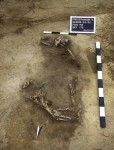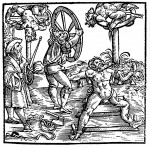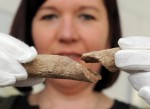 Last October, archaeologists surveying the site of planned road work on federal highway 189 in Groß Pankow, Brandenburg, Germany, unearthed human remains. They had already found some Bronze Age materials on the site — fragments of pottery, a stone axe — from the 1st millennium B.C., but nothing of great note. The rounded grave pit at first glance looked much like the pits from the Bronze Age settlement, but the skeletal remains, on the other hand, were immediately arresting. The bones were oddly positioned, the arms angled sideways up to the neck, the thigh bones turned backwards. They were also brutally broken, all the long bones shattered with many pieces missing.
Last October, archaeologists surveying the site of planned road work on federal highway 189 in Groß Pankow, Brandenburg, Germany, unearthed human remains. They had already found some Bronze Age materials on the site — fragments of pottery, a stone axe — from the 1st millennium B.C., but nothing of great note. The rounded grave pit at first glance looked much like the pits from the Bronze Age settlement, but the skeletal remains, on the other hand, were immediately arresting. The bones were oddly positioned, the arms angled sideways up to the neck, the thigh bones turned backwards. They were also brutally broken, all the long bones shattered with many pieces missing.
 It was clear the person had died far more recently than 1,000 B.C. An iron belt buckle found in the grave provided a general date of between the 15th and 17th centuries. Further examination revealed the deceased was a man in his mid to late 30s who had been executed on the wheel. His bones are in more than a thousand pieces. This is the first time a skeleton of someone broken on the wheel has been found in Germany, even though judicial execution by wheel was employed in the Holy Roman Empire from the Middle Ages to the 19th century.
It was clear the person had died far more recently than 1,000 B.C. An iron belt buckle found in the grave provided a general date of between the 15th and 17th centuries. Further examination revealed the deceased was a man in his mid to late 30s who had been executed on the wheel. His bones are in more than a thousand pieces. This is the first time a skeleton of someone broken on the wheel has been found in Germany, even though judicial execution by wheel was employed in the Holy Roman Empire from the Middle Ages to the 19th century.
 This is not a coincidence. The whole point of the wheel was to display the broken bodies until they rotted away entirely, leaving the bones for carrion birds to enjoy. The punishment was reserved for the worst criminals — serial killers, murderers who killed someone during the commission of another crime, killers of kin — and the destruction of the body in a slow, public fashion did double-duty as the most gruesome retribution and as a stern warning to the public.
This is not a coincidence. The whole point of the wheel was to display the broken bodies until they rotted away entirely, leaving the bones for carrion birds to enjoy. The punishment was reserved for the worst criminals — serial killers, murderers who killed someone during the commission of another crime, killers of kin — and the destruction of the body in a slow, public fashion did double-duty as the most gruesome retribution and as a stern warning to the public.
 Death by wheel was usually a two-stage process. First a large spoked wagon wheel would be slammed onto the large bones of the arms and legs, breaking them in two places each. Then the wheel would strike the spine, breaking it. With the body’s skeletal structure in pieces, the condemned was then tied to the wheel, his limbs woven in and out of the spokes. Finally the wheel was raised on a pike and planted into the ground. If the man wasn’t dead yet, and he usually wasn’t unless he was fortunate enough to have been deliberately struck with fatal blows to the chest and abdomen as an act of mercy, he would die in slow unspeakable agony over the course of hours, often days.
Death by wheel was usually a two-stage process. First a large spoked wagon wheel would be slammed onto the large bones of the arms and legs, breaking them in two places each. Then the wheel would strike the spine, breaking it. With the body’s skeletal structure in pieces, the condemned was then tied to the wheel, his limbs woven in and out of the spokes. Finally the wheel was raised on a pike and planted into the ground. If the man wasn’t dead yet, and he usually wasn’t unless he was fortunate enough to have been deliberately struck with fatal blows to the chest and abdomen as an act of mercy, he would die in slow unspeakable agony over the course of hours, often days.
In the dead of Groß Pankow for the first time the torture could be accurately documented: A big blow for example, had torn away half his face, as can be seen on the damaged skull.
This could mean that the offender previously received the fatal coup de grace by the executioner. However, this happened rarely. More often the delinquent – before he was dead – fell off the wheel. This was then as God’s judgment, the delinquent was then free.
 Obviously that’s not what happened here. He died in a horrific fashion. Why this wheeled man had his bones collected and respectfully buried, we do not know. The place where he was found was an old military road. It could have been a place used for a mobile execution rather than a permanent gallows or regular killing zone. With no police presence, a family member of the deceased or just someone with an ounce of compassion could have removed the broken body and buried it.
Obviously that’s not what happened here. He died in a horrific fashion. Why this wheeled man had his bones collected and respectfully buried, we do not know. The place where he was found was an old military road. It could have been a place used for a mobile execution rather than a permanent gallows or regular killing zone. With no police presence, a family member of the deceased or just someone with an ounce of compassion could have removed the broken body and buried it.
Reading this posting turns an historical abstraction into cold reality.
Hieronymus Bosch’s “Procession to Calvary” depicts such wheels, minus bodies. Lech Majewski’s film “The Mill and the Cross” is based on this work (it’s a beautiful film) and includes a segment with a man being placed on a wheel, although lacking the gruesome torture described here.
Death by wheel is a horrible but nevertheless fascinating thing.
PS – I stop by your blog all the time; thank you for all you do.
Lovely blog overall. This one is certainly a rare find.
I don’t know the history of this in Germany but in France by the mid-18th century the actual breaking was done on a St. Andrew’s cross (though Cartouche, earlier, seems to have been broken directly on a wheel).
Philip Thicknesse left this vivid account (1766):
“He was broke upon the wheel, so it is called; but the wheel is what the body is fixed, upon to be, exposed on’ the high-road, after the execution. This man’s body, however, was burnt. The miserable wretch (a young strong man) was brought, in the. evening, by a faint torch light, to a chapel, near the place of execution, where he might haye continued in prayer till midnight; but after one hour spent there, he walked steadily from the chapel to the scaffold, accompanied by his confessor, who with great earnestness continually presented to him, and bade him kiss the crucifix he carried in his hand. After he had ascended the scaffold and turned his eyes towards heaven, he very willingly submitted to the dreadful sentence, laying himself upon his back, and extended his arms and legs over a cross, which was laid flat, and fixed fast upon the scaffold for that purpose, to which he was then securely tied by the executioner and his mother, who assisted her son, in this dreadful business. Part of the cross was cut away, in eight places, so as to leave a hollow vacancy, where the blows were to be given, which are, between the shoulder and elbow, elbow and wrist, thigh and hip, and knee and ancle. When the wretch was securely tied down, the end of a rope which was round his neck, with a running noose, was brought through a hole a hole in, and under the scaffold; this was to give the Coup de Grace, after breaking: a Coup which relieved him, and all the agitated spectators, from an infinite degree of misery, except only, the executioner and his mother, for they both seemed to enjoy the deadly office. The blows were then given, with a heavy piece of iron, made in the form of a butcher’s cleaver without an edge, and the bones of the arms, legs and thighs were broken in eight places; at each blow, the sufferer called out, Mon Dieu! without saying another Word, or even uttering a single groan. During all this time, the Confessor called upon him continually to kiss the cross, and to remember how Christ, his Redeemer suffered for us. Indeed, there was infinite address, as well as piety, in the conduct of the Confessor; for he would not permit this miserable wretch to have one moment’s reflexion about his bodily sufferings, while a matter of so much more importance to him was depending; but those eight blows seemed nothing to two dreadful after-claps, for the executioner then untied the body, turned his back upwards, and gave him two blows on the small of the back with the same iron weapon; and yet, even that did not put an end to the life and sufferings of the malefactor for the finishing stroke was, after all, done by the halter, and then the body being rolled up like a bundle of old clothes, was thrown into a great fire, and consumed to ashes. There were two or three executions soon after, but of a more moderate kind. Yet I hope I need not tell you, that I shall never attend another; and would have made my escape from this, had it been possible.”
http://books.google.com/books?id=I2TF480urGoC&dq=inauthor%3Athicknesse%20wheel&pg=PA49#v=onepage&q&f=false
Need to see this film, thanks for the info. :))